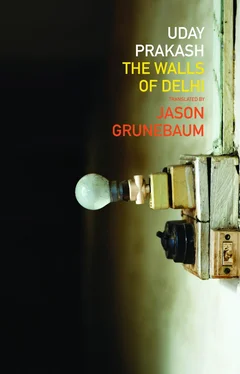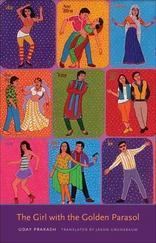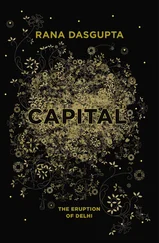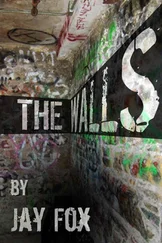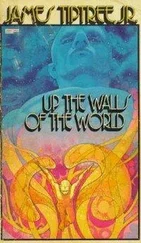And so the story goes with all of them. Azad wasn’t coming back. What about me? I am Vinayak Dattatreya! Am I any safer than them? I’ve fallen to a new low, with no work, squeezed on all sides, and now I spend all day long sitting at Sanjay’s paan stall: stressed out, useless, numb.
Now I’m just another piece of that world, no different from the rest. I don’t have the courage anymore to come home and face the way my wife and son look at me. I watch my son eat his food at dinnertime, chewing ever so slowly, and I feel as though he’s walking down a long flight of stairs, down into a darkness where I’ll never see his face again. My soul — or whatever it is you want to call it — quietly weeps. Believe me that every time I do a bit of soul searching to try and figure out what’s wrong with me and why I have such bad luck, I come face-to-face with every single rotten thing about this whole system we live in — a system surely created by some underworld gang.
One day I’ll be the one to disappear from this little corner of the neighbourhood: it’s a fact. The poor, the sick, the street corner prophets, the lowly, the unexceptional — all gone! They’ve vanished from this new Delhi of wealth and wizardry, never to return, not here, not anywhere else. Not even memories of them will remain.
They’re like the tears of an ill-fated fakir, leaving only the tiniest trace of moisture on the ground after he’s got up and gone. The damp spot on the ground from his spit and silent tears serves as protest against the injustice of his time. THE RUINED STATUES OF HISTORY AND THE GREAT COMMUTE FROM CORONATION PARK
But it seems we’ve got off track. I was talking about Sanjay’s, the neighbourhood paan shop (right near my flat), and then I got carried away to sixteenth century ruins near the bypass. But that’s what happens. Try it yourself: look closely at anyone from a forgotten corner of any neighbourhood, and you’ll slowly but surely find yourself entering a tunnel inhabited by very different characters. You’ll notice that these city creatures are lodged in unfamiliar sorts of dwellings. But don’t expect to read any news about the bad things that happen to them. Newspapers’ raison d’etre is to hide that news, to edit out everything that they suffer.
If you’re in Delhi, and you’re the kind of person who doesn’t sleep very well at night, and, at three or four in the morning, you’re up, and you leave the house to go wandering around, then you’ve surely seen the road that goes toward Raj Ghat from Kingsway Camp, now called Vijaynagar. If you head toward Nirankari Colony or Mukherjee Nagar from the crossing at Vijaynagar, you’ll find yourself in a desolate place that’s known as Coronation Park. Even though they’ve turned the place into a big, beautiful park, it’s the spot that gave the area the name of Kingsway Camp.
They say that during the time of the British, when George V or Charles came here (I don’t know which one), all the Indian kings and queens of all of the princely states set up camp right there, gathering as one in order to warmly welcome their Imperial King. They say that it was a little like the reception that Bill Clinton got when he visited. The kings and rulers of the princely states performed a crowning ceremony, or the coronation of their English King. The speech that the King of England gave has been stored in the national archives, and the copy of the speech is considered a very important document in the history of India. On top of that, the King of England had a statue of himself installed slap bang in the centre of India Gate, under a lovely canopy. After the British returned to England in 1947, that statue, along with others dating from British rule, were uprooted, collected, and relegated to Coronation Park at Kingsway Camp.
In the years after Independence, the park became a magnet for loonies, beggars, the disabled, lepers, the maimed, druggies, and other wandering, unsettled individuals. They mutilated the statues, turning them into stoves, grindstones, sledgehammers, and using them in all sorts of other creative ways. A king’s head was severed, a hand was taken, a leg removed. The torsos of the other statues lie scattered on the ground in a frightening, limbless state, surrounded by tall grass and shrubs. As soon as the sun sets, the special inhabitants of this park converge from each and every corner of Delhi, and pass the night among the felled, ruined figures.
So, as I was saying, if you’re in Delhi, and things are such that an endless nightmare loops in your head all night long, and, in a fit of restlessness and depression, you go out wandering in the middle of the night, or right before daybreak, then you’ve seen them: the mass of human beings skulking out of Coronation Park, Kingsway Camp, loping toward Raj Ghat on Mall Road. The dark of the night hasn’t fully dissipated, and dawn is still a hazy mystery, while you watch a great mass of broken, maimed, crippled, halfway-human beings, like characters from a Fellini or Antionioni film, as they quietly pass into the capital.
They’re like a group of survivors of a devastating bombing campaign from a twentieth-century war, who pick themselves out of the rubble in the city that was the scene of the carnage, and carry their wounded bodies to a place of refuge, in search of a final protector.
After the sun comes out, you see them everywhere in the capital: at the train station, at bus stands, in temples, at holy sites, at intersections, on sidewalks. These are not the slum dwellers: they form their own constituency — one that’s only got bigger since Independence.
In the corner of the neighbourhood where Sanjay’s is, sometimes you’ll also see one-eyed Rupna Mandal whose face is dotted with white spots from vitiligo selling colourful paper flowers and pinwheels. She, too, journeys from Coronation Park. Sometimes Sohna, a nine-year-old with no arms, another of the dispossessed, also comes along.
You see how this tunnel that starts from the little corner of the street that’s home to Sanjay’s paan stall leads to the Bypass ruins, from there to Kingsway Camp, and from there extends to each and every corner of the capital. Enter the tunnel, quietly make your way deeper and deeper, and you’ll soon discover that the tunnel traverses the entire length of the country; then, it continues below the ocean floor, until, finally, it circumnavigates the entire subterranean earth. This is a different kind of globalisation, one so stealthy and so secret that not a single sociologist in the whole wide world knows a thing about it. Those who do know keep quiet, stay put, and wait until tomorrow. But the important thing to remember is this: the tunnel originates mere steps from my home.
Walk outside your home and take a good look at the little crowd that hangs out at the shop or stall or cart — and who knows? You might find where the tunnel comes out. MEETING RAMNIVAS, AND THE START OF THE SECRET
It was at this little corner of the street I first met Ramnivas. He’d moved to Delhi twenty years earlier from Shahipur, a small village in Handiya district near Allahabad, along with his father, Babulla Pasiya. In the beginning, Babulla washed pots and pans in a roadside dhaba food shack on Rohatak Road, and was later promoted after learning how to cook in a tandoori oven. Five years ago, he built a makeshift house in Samaypur Badli village in northwest Delhi, itself a settlement of tin shacks and huts — and just like that, his family became Delhites. Even though the settlement was illegal — city bulldozers could come and demolish everything at any time — he’d procured an official ration card after last year’s election, and increasingly entertained the hope they wouldn’t get displaced.
Ramnivas Pasiya was twenty-seven, twenty-eight, max. Ramlal Sharma, the local council man, put in a good word and got him part-time work as a city sanitation worker. His area was in south Delhi, in Saket. At eight in the morning, he’d put his plastic lunch tiffin, full of roti, into his bag, and catch a DTC bus toward Daula Kuan, and then transfer to another bus that took him to Saket. Ramnivas would punch in, grab his broom and other cleaning equipment and head toward the neighbourhood he was responsible for. When he got hungry in the afternoon, he’d buy a couple of rupee’s worth of kulche, and then eat his fill along with the roti he’d brought from home. His wife, Babiya, had made the roti; they’d been married when she was seventeen. Now he was the father of two — a boy and a girl — and would have had two sons if one hadn’t died.
Читать дальше
